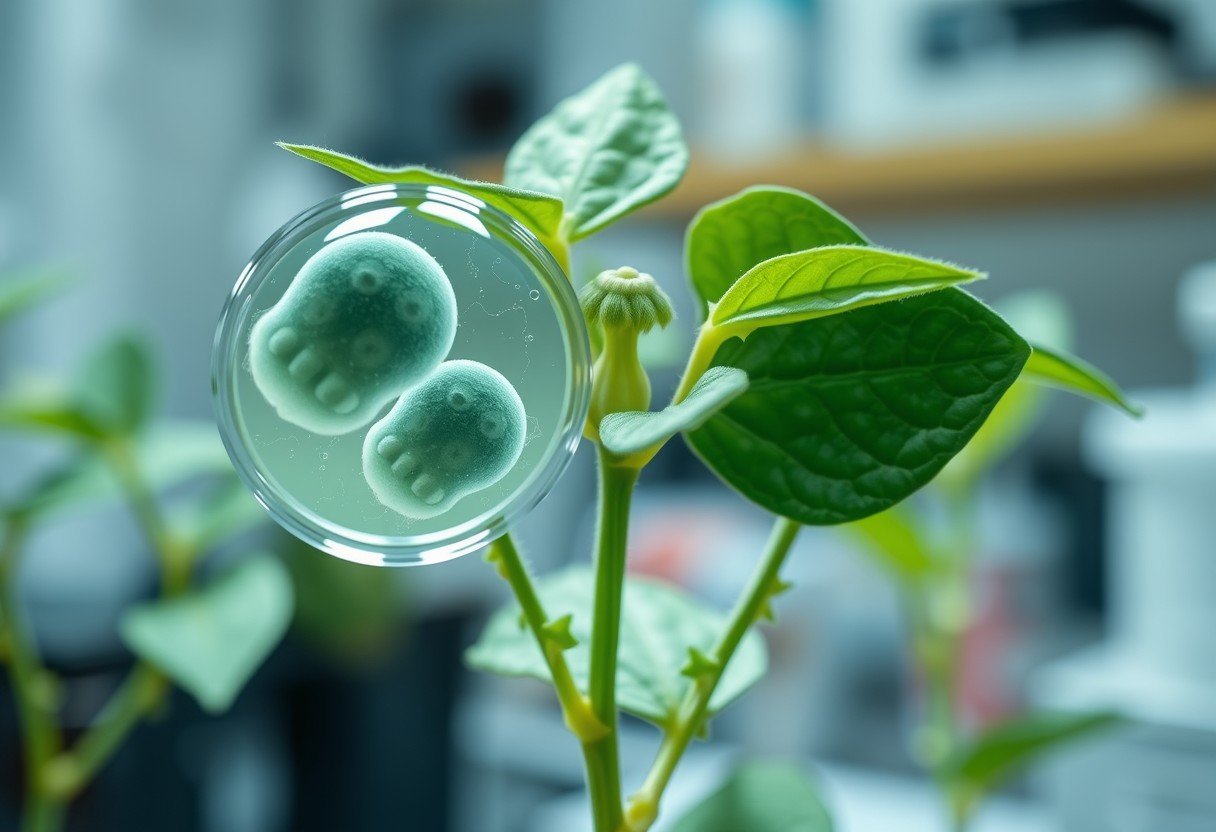Imagine a world without the air we breathe. Roughly 3 billion years ago, that was Earth’s reality. Then, tiny microscopic organisms began a process that would completely reshape our planet’s atmosphere and pave the way for complex life. This incredible transformation, driven by the first photosynthetic life, is known as the Oxygen Revolution. It’s the story of how our world learned to breathe, setting the stage for the evolution of animals, plants, and eventually, us.
What Was Earth’s Atmosphere like Before Oxygen?
Before this great change, Earth’s sky was not the familiar blue we see today. The early atmosphere was a thick mixture of gases like nitrogen, carbon dioxide, and methane, but it had almost no free oxygen. This oxygen-free, or anoxic, environment was toxic to the kind of life we know now.
In this world, life was simple and small. The only inhabitants were tiny, single-celled organisms known as anaerobes. These microbes thrived without oxygen, using other chemicals to get their energy. Earth was a quiet, alien planet dominated by microorganisms that lived in a world without breath.
Geological processes like intense volcanic activity constantly pumped more gases into the atmosphere, shaping this early environment. It was in this chemical soup that the first key players in our planet’s transformation were about to make their debut.
Who Were the Tiny Architects of a New World?
The heroes of this story are a type of bacteria called cyanobacteria. You might know their descendants today as blue-green algae. These were some of the first organisms on Earth to figure out a revolutionary new way to make food: photosynthesis.
Using energy from the sun, cyanobacteria took in carbon dioxide and water and converted them into sugars for energy. But this process had a critical byproduct that they released as waste: oxygen. For billions of years, these tiny organisms tirelessly pumped this new gas into the oceans and, eventually, the atmosphere.
This wasn’t just a small change; it was the single most important biological event in our planet’s history. Cyanobacteria were terraforming the planet on a massive scale, long before any complex life existed. They were the architects of an oxygen-rich world.
The Great Oxidation Event: A Planet Transformed
For millions of years, the oxygen produced by cyanobacteria didn’t just float into the air. First, it dissolved in the oceans and reacted with iron, causing it to rust and sink to the seafloor. This created massive geological formations we can still see today.
However, around 2.4 billion years ago, the iron in the oceans was mostly used up. With nowhere else to go, the oxygen began to escape into the atmosphere in huge quantities. This period is known as the Great Oxidation Event (GOE). It marks the point where Earth’s atmosphere fundamentally and permanently changed from anoxic to oxic (oxygen-rich).
How Did Life Respond to the Oxygen Crisis?
The rise of oxygen had two very different effects on life. For the existing anaerobic organisms, it was a catastrophe. For new forms of life, it was the greatest opportunity in history.
For the anaerobic life that dominated the early Earth, oxygen was a deadly poison. It damaged their cells and disrupted their metabolic processes, leading to the planet’s first major mass extinction. Many anaerobic species died out, while others retreated to oxygen-free environments, like deep-sea vents or mud, where their descendants still live today.
On the other hand, some organisms evolved to not only tolerate oxygen but to use it. This new process, called aerobic respiration, was incredibly efficient.
- More Energy: Using oxygen allowed organisms to extract far more energy from their food compared to anaerobic methods.
- Greater Complexity: This energy surplus fueled the evolution of larger, more complex cells and, eventually, multicellular life like plants and animals.
- New Possibilities: The oxygen-rich environment created new ecological niches, driving a burst of evolutionary innovation.
This event forever split the tree of life, creating a world where oxygen-breathing organisms would come to dominate.
What Evidence Proves the Oxygen Revolution Happened?
Scientists know about this ancient event because the planet kept a detailed diary in its rocks. By studying geology, we can see clear evidence of this dramatic atmospheric shift.
One of the most important clues is found in stromatolites. These are layered rock formations created by ancient colonies of cyanobacteria. Finding these fossils, some dating back over 3 billion years, tells us that photosynthetic organisms were active on the early Earth.
The chemical evidence is even more direct. Rocks from before the Great Oxidation Event look very different from those that came after. Geologists have identified key markers that paint a clear picture of this transition.
| Evidence Type | Description | What It Tells Us |
| Banded Iron Formations (BIFs) | Alternating layers of iron oxide (rust) and shale in ancient rock. | Shows that oxygen was building up in the oceans, causing dissolved iron to rust and settle on the seafloor. |
| Red Beds | Red-colored sedimentary rocks containing oxidized iron. | Indicates that oxygen levels were high enough in the atmosphere to rust iron on land. These only appear after the GOE. |
| Carbon Isotope Ratios | Changes in the ratio of different types of carbon in rocks. | Points to a massive boom in photosynthetic activity, as organisms preferentially use a lighter type of carbon. |
Lasting Legacies: The Ozone Layer and Modern Life
The Oxygen Revolution didn’t just change life; it gave our planet a protective shield. As oxygen filled the upper atmosphere, some of it was converted by sunlight into ozone (O3). This formed the ozone layer.
The creation of the ozone layer was a critical step for the evolution of life on land. It blocks most of the sun’s harmful ultraviolet (UV) radiation, which can damage DNA. Without this shield, complex life would have been confined to the safety of the oceans. The ozone layer made it possible for plants and animals to eventually colonize the continents.
Every complex organism you see today, from a mushroom to a whale, owes its existence to the oxygen-rich atmosphere created billions of years ago. It is the foundation of our modern biosphere.
Lessons from the Past for Our Planet’s Future
The story of the Oxygen Revolution is a powerful reminder of how profoundly life can impact a planet’s environment. The actions of tiny bacteria completely remade the world. Today, another species, humans, is changing the atmosphere again, this time by adding massive amounts of carbon dioxide.
Understanding this ancient event highlights the delicate balance of our planet’s systems. It shows that atmospheric changes can have far-reaching and sometimes unexpected consequences. By studying our planet’s past, we can better appreciate the need for sustainable practices to protect its future. The lesson is clear: the health of the biosphere and the composition of the atmosphere are deeply intertwined.
Frequently Asked Questions about the Oxygen Revolution
What caused the Oxygen Revolution?
The Oxygen Revolution was caused by early photosynthetic organisms, primarily cyanobacteria. These microbes used sunlight to make food and released oxygen as a waste product, which gradually accumulated in the atmosphere.
When did the Great Oxidation Event happen?
The Great Oxidation Event (GOE) marks the period when oxygen began to significantly accumulate in the atmosphere. Most scientific evidence places this event around 2.4 to 2.3 billion years ago.
How did oxygen first appear on Earth?
Oxygen first appeared as a byproduct of photosynthesis performed by cyanobacteria. For hundreds of millions of years, this oxygen was absorbed by oceans and landmasses before it could build up in the atmosphere.
Was the Oxygen Revolution bad for life?
It was catastrophic for most life at the time, which was anaerobic and could not survive in oxygen. This led to a mass extinction but also created the conditions necessary for the evolution of more complex, oxygen-breathing life.
What is the most important legacy of the Oxygen Revolution?
Its most important legacy is the creation of an oxygen-rich atmosphere that allowed for aerobic respiration, a much more efficient way to produce energy. This paved the way for the evolution of all complex life, including animals and humans.









Leave a Comment